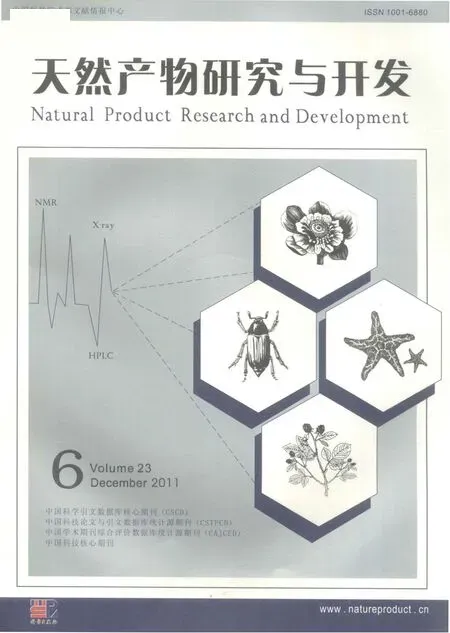旋覆花的化学成分研究
2011-03-16覃江江朱佳娴金慧子张卫东
覃江江,朱佳娴,朱 燕,严 岚,金慧子*,张卫东,2*
1上海交通大学药学院,上海200240;2第二军医大学药学院,上海200433
Introduction
Inula japonica Thunb.,which belongs to Asteraceae,is widespread in Europe,Africa,Asia,and Mediterranean[1].As one of the most important members in this genus,I.japonica has been reported to possess diverse biological activities,such as anti-tumor[2-4],anti-diabetic[5],and hypolipidemic[5]activities.During our search for bioactive compositions from this plant,anthranilic acid derivatives[6]and sesquiterpenes[2]have been reported by us before.In this paper,we described the isolation and structure elucidation of coumarins and other constituents which were isolated from this genus for the first time.
Experimental
General
1H and13C NMR spectra were recorded on Bruker DRX-500 spectrometers at 500 and 125 MHz,respectively.ESIMS spectra were recorded on Varian MAT-212 mass spectrometer.A preparative column(Shimadzu PRC-ODS EV0233)was used for preparative HPLC (Shimadzu LC-6AD).All solvents used were of analytical grade(Shanghai Chemical Company,Ltd.).TLC analysis was run on HSGF254silica gel plates(10-40 μm,Yantai,China).Column chromatography was performed on silica gel(100-200,200-300 mesh,Yantai,China),silica gel H(10-40 μm,Qingdao,China)and Sephadex LH-20(Pharmacia Co.Ltd.).
Plant material
The aerial parts of I.japonica were collected in Anhui province,PR China,in October,2006,and were authenticated by Professor Huang Baokang,Department of Pharmacognosy,School of Pharmacy,Second Military MedicalUniversity.A voucher specimen (No.2007XFH1)was deposited at School of Pharmacy,Shanghai Jiao Tong University.
Extraction and isolation
The dried aerial parts of I.japonica(20.0 kg)were powdered and extracted with 95% ethanol for three times at room temperature.The ethanolic extract was successively partitioned with petroleum ether(PE),CH2Cl2,EtOAc,and n-BuOH,respectively.The CH2Cl2fraction(84.5 g)was chromatographed on a silica gel column eluting with a step gradient of CH2Cl2· MeOH(100∶0,50∶1,20∶1,10∶1,5∶1,2∶1,1∶1)to give subfractions.Then subfractions were isolated and purified in a combination of sicila gel,Sephadex LH-20 and preparative HPLC to afford compounds 3(6.0 mg),4(10.8 mg),5(6.6 mg),6(3.0 mg),7(3.0 mg),8(16.0 mg),9(4.0 mg),and 10(26.0 mg).And from PE fraction(100.8 g),1(4.0 mg)and 2 (6.5 mg)were obtained.
Results and Discussion
Ayapin(1)White amorphous powder,ESI-MS m/z 213[M+Na]+,189[M-H]-.1H NMR(CDCl3,500 MHz)δ:7.58(1H,d,J=10.0 Hz,H-4),6.83(2H,s,H-5,8),6.28(1H,d,J=10.0 Hz,H-3),6.07 (2H,s,H-11);13C NMR(CDCl3,125 MHz)δ:161.2 (C-2),113.5(C-3),143.4(C-4),105.0(C-5),144.9(C-6),151.3(C-7),98.4(C-8),143.4(C-9),112.7(C-10),102.4(11-OCH2O-).The MS and NMR data were consistent with those of ayapin[7].
7-Hydroxycoumarin(2)White amorphous powder,ESI-MS m/z 163[M+H]+,161[M-H]-.1H NMR (DMSO-d6,500 MHz)δ:10.53(1H,brs,7-OH),7.92(1H,d,J=9.0 Hz,H-4),7.52(1H,d,J=8.0 Hz,H-5),6.79(1H,dd,J=8.0,2.0 Hz,H-6),6.71 (1H,d,J=2.0 Hz,H-8),6.20(1H,d,J=9.0 Hz,H-3);13C NMR(DMSO-d6,125 MHz)δ:161.2(C-2),113.0(C-3),144.4(C-4),129.6(C-5),111.3(C-6),160.3(C-7),102.1(C-8),155.4(C-9),111.2 (C-10).The MS and NMR data were consistent with those of 7-hydroxycoumarin[8].
Daphnetin(3) White amorphous powder,ESI-MS m/z 201[M+Na]+,177[M-H]-.1H NMR(CD3OD, 500 MHz)δ:7.85(1H,d,J=10.0 Hz,H-4),7.01 (1H,d,J=8.0 Hz,H-5),6.84(1H,d,J=8.0 Hz,H-6),6.20(1H,d,J=10.0 Hz,H-3);13C NMR (CD3OD,125 MHz)δ:163.5(C-2),112.1(C-3),146.7(C-4),120.2(C-5),113.9(C-6),151.1(C-7),133.5(C-8),145.0(C-9),113.8(C-10).The MS and NMR data were consistent with those of daphnetin[9].
Scopoletin(4) White amorphous powder,ESI-MS m/z 193[M+H]+,215[M+Na]+.1H NMR (CDCl3,500 MHz)δ:7.60(1H,d,J=10.0 Hz,H-4),6.92(1H,s,H-5),6.85(1H,s,H-8),6.27(1H,d,J=10.0 Hz,H-3),3.95(3H,s,6-OCH3);13C NMR(CDCl3,125 MHz)δ:161.4(C-2),113.4(C-3),143.3(C-4),107.5(C-5),150.3(C-6),149.7 (C-7),103.2(C-8),144.0(C-9),111.5(C-10),56.4(6-OCH3).The MS and NMR data were consistent with those of scopoletin[10].
Wedelolactone(5) White amorphous powder,ESIMS m/z 651[2M+Na]+,313[M-H]-,627[2MH]-.1H NMR(DMSO-d6,500 MHz)δ:10.80(1H,brs,5-OH),9.38(2H,brs,11,12-OH),7.25(1H,s,H-10),7.17(1H,s,H-13),6.63(1H,s,H-6),6.46 (1H,s,H-8),3.82(3H,s,7-OCH3);13C NMR(DMSO-d6,125 MHz)δ:158.8(C-1),101.6(C-2),155.2 (C-3),96.7(C-4),154.8(C-5),93.2(C-6),162.2 (C-7),98.1(C-8),157.7(C-9),104.5(C-10),145.4(C-11),144.3(C-12),98.8(C-13),148.8(C-14),113.7(C-15),55.7(3H,s,7-OCH3).The MS and NMR data were consistent with those of wedelolactone[11].
Citrusin C(6) White amorphous powder,ESI-MS m/z 349[M+Na]+,325[M-H]-.1H NMR(CD3OD,500 MHz)δ:7.08(1H,d,J=8.2 Hz,H-6),6.82 (1H,d,J=1.8 Hz,H-3),6.72(1H,dd,J=8.2,1.8 Hz,H-5),5.94(1H,m,H-8),5.03(2H,m,H-9),4.84(1H,d,J=7.5 Hz,H-1'),3.86(1H,dd,J= 12.2,1.5 Hz,H-6'a),3.83(3H,s,2-OCH3),3.68 (1H,dd,J=12.0,5.0 Hz,H-6'b),3.48(1H,m,H-2'),3.45(1H,m,H-5'),3.38(2H,m,H-3',4'),3.33(1H,m,H-7);13C NMR(CD3OD,125 MHz)δ: 146.7(C-1),151.1(C-2),114.5(C-3),136.8(C-4),122.4(C-5),118.6(C-6),41.1(C-7),139.3(C-8),116.1(C-9),103.4(C-1'),75.3(C-2'),78.5 (C-3'),71.7(C-4'),78.2(C-5'),62.8(C-6'),57.0 (2-OCH3).The MS and NMR data were consistent with those of citrusin C[12].
Medioresinol(7)White amorphous powder,ESI-MS m/z 389[M+H]+,387[M-H]-.1H NMR(CDCl3,500 MHz)δ:6.90(1H,d,J=8.0 Hz,H-5'),6.88 (1H,d,J=2.0 Hz,H-2'),6.82(1H,dd,J=8.0,2.0 Hz,H-6'),6.59(2H,s,H-2,6),5.59(1H,brs,4'-OH),5.48(1H,brs,4-OH),4.75(1H,d,J=4.5 Hz,H-7'),4.72(1H,d,J=4.5 Hz,H-7),4.26(2H,m,H-9),3.91(9H,s,3,5,3'-OCH3),3.90(2H,m,H-9'),3.10(2H,m,H-8,8');13C NMR(CDCl3,125 MHz)δ:134.3(C-1),102.8(C-2,6),147.2(C-3,5),132.9(C-4),86.2(C-7),54.4(C-8),71.9(C-9),132.2(C-1'),108.6(C-2'),145.3(C-3'),146.7 (C-4'),114.3(C-5'),119.0(C-6'),85.8(C-7'),54.1(C-8'),71.6(C-9'),56.4(3,5-OCH3),56.0 (3'-OCH3).The MS and NMR data were consistent with those of medioresinol[13].
Syringic acid(8) Yellow amorphous powder,ESIMS m/z 221[M+Na]+,197[M-H]-.1H NMR(DMSO-d6,500 MHz)δ:12.58(1H,brs,7-COOH),9.18 (1H,brs,4-OH),7.21(2H,s,H-2,6),3.80(6H,s,3,5-OCH3);13C NMR(DMSO-d6,125 MHz)δ:120.4 (C-1),106.9(C-2,6),147.4(C-3,5),140.2(C-4),167.2(C-7),56.0(3,5-OCH3).The MS and NMR data were consistent with those of syringic acid[14].
Vanillic acid(9)White amorphous powder,ESI-MS m/z 167[M-H]-.1H NMR(CD3OD,500 MHz)δ: 7.57(1H,brs,H-2),7.52(1H,brd,J=8.0 Hz,H-6),6.80(1H,d,J=8.0 Hz,H-5),3.89(3H,s,3-OCH3);13C NMR(CD3OD,125 MHz)δ:123.0(C-1),114.0(C-2),151.5(C-3),148.4(C-4),115.5 (C-5),124.9(C-6),170.0(C-7),56.4(3-OCH3) .The MS and NMR data were consistent with those of vanillic acid[15].
Isovanillic acid(10)White amorphous powder,ESIMS m/z 167[M-H]-.1H NMR(CD3OD,500 MHz)δ: 7.56(1H,dd,J=8.0,2.0 Hz,H-6),7.55(1H,d,J= 2.0 Hz,H-2),6.84(1H,d,J=8.0 Hz,H-5),3.89 (3H,s,4-OCH3);13C NMR(CD3OD,125 MHz)δ: 123.1(C-1),115.8(C-2),148.6(C-3),152.6(C-4),113.8(C-5),125.3(C-6),170.1(C-7),56.4(4-OCH3).The MS and NMR data were consistent with those of isovanillic acid[16].
1 Lin R,Yu DJ,Wu ZY.Inula L.In:Flora of China.Beijing: Science Press,1989,263-281.
2 Qin JJ,Jin HZ,Zhang WD,et al.Japonicones A-D,bioactive dimeric sesquiterpenes from Inula japonica Thunb..Bioorg Med Chem Lett,2009,19:710-713.
3 Wang CM,Jia ZJ,Zheng RL.The effects of 17 sesquiterpenes on cell viability and telomerase activity in the human ovarian cancer cell line HO-8910.Planta Med,2007,73:180-184.
4 Yang C,Wang CM,Jia ZJ.Sesquiterpenes and other constituents from aerial parts of Inula japonica.Planta Med,2003,69:662-666.
5 Shan JJ,Yang M,Ren JW.Anti-diabetic and hypolipidemic effects of aqueous-extract from the flower of Inula japonica in alloxan-induced diabetic mice.Biol Pharm Bull,2006,29: 455-459.
6 Qin JJ,Jin HZ,Zhang WD,et al.Anthranilic acid derivatives from Inula japonica.Chin Chem Lett,2008,19:556-558.
7 Zhang GN,Zhang CF,Luo Y,et al.Chemical constituents of Dendrobium thyrsiflorum Rchb.f(II).Chin J Nat Med,2005,3:287-290.
8 Hu XJ,Jin HZ,Su J,et al.Coumarins from Daphne retusa.Chin J Nat Med,2009,7:34-36.
9 Zhang W,Zhang WD,Li TZ,et al.Studies on the chemical constituents in roots of Daphne odora var,atrocaulis.China J Chin Mater Med,2005,30:513-515.
10 Luo JG,Kong LY.Lipophilic constituents from the leaves of Ipomoea batatas(CV.Simon).Nat Prod Res Dev,2005,17: 166-168.
11 Zhang JS,Guo QM.Studies on the chemical constituents of Eclipta prostrata(L).Acta Pharm Sin,2001,36:34-37.
12 Yin YQ,Luo JG,Kong LY.Studies on the chemical constituents of Ipanoea batatas Lam.Chin Tradit Herb Drugs,2007,38:508-510.
13 Li D,Liu MS,Li ZL,et al.Studies on chemical constituents of Heliciopsis lobata II.China J Chin Mater Med,2008,33: 409-411.
14 Dong Li,Li L,Liao ZH,et al.Chemical constituents in root of Rhodiola bupleuroides.Acta Bot Boreal-Occident Sin,2007,27:2564-2567.
15 Ren DC,Qian SH,Yang NY,et al.Chemical constituents of Changium smyrnioides.J Chin Med Mater,2008,31:47-49.
16 Li XH,Lin LD,Wu P,et al.Chemical constituents from barks of Endospermum chinense Benth.J Trop Subtrop Bot,2007,15:35-39.
